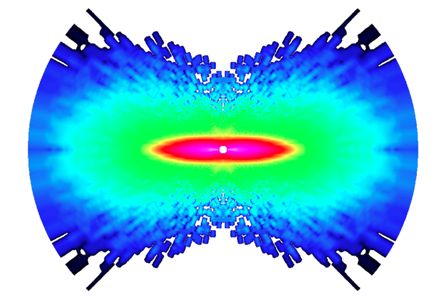First image of two atoms bonding to form a molecule
15 March 2012
The world's first image of two atoms bonding together to form a molecule has been captured by a team at Ohio University using ultrafast laser pulses.
The team used laser pulses to knock one electron out of its natural orbit in one of the atoms, just as the two atoms were bonding together. When the electron fell back into place, it emitted an energy signal that scattered around the newly forming molecule as a flash of light would scatter around an object, or ripples would scatter in a pond. The research has been published in the journal Nature.
Principal investigator Louis DiMauro of Ohio State University said that the feat marks a first step toward not only observing chemical reactions, but also controlling them on an atomic scale.
“Through these experiments, we realized that we can control the trajectory of the electron when it comes back to the molecule, by adjusting the orientation of the laser that launches it,” said DiMauro, who is a professor of physics at Ohio State. “The next step will be to see if we can hit the electron in just the right way to actually control a chemical reaction.”
A more common imaging technique involves shooting a molecule with an electron beam, bombarding it with millions of electrons per second. The researchers deemed the new single-electron approach more reliable, based on theoretical developments by the paper’s coauthors at Kansas State University.
“If we shot an electron beam from outside the molecule, there would only be a certain probability that one of the electrons would scatter off the molecule,” explained Ohio State postdoctoral researcher Cosmin Blaga. “But in this case, when we use a laser to launch an electron from inside the molecule we are studying, we have a 100 percent probability that it will fall back into the molecule and scatter.”
The technique, called laser induced electron diffraction (LIED), is commonly used in surface science to study solid materials. This is the first time anyone has used LIED to study a single molecule as it formed.
 |
|
The world's first image of two atoms forming a
molecule. Researchers at Ohio State University and Kansas State University have captured the first-ever images of atoms moving in a molecule. Shown here is molecular nitrogen. The researchers used an ultrafast laser to knock one electron from the molecule, and recorded the diffraction pattern that was created when the electron scattered off the molecule. The image highlights any changes the molecule went through during the time between laser pulses: one quadrillionth of a second. The constituent atoms¹ movement is shown as a measure of increasing angular momentum, on a scale from dark blue to pink, with pink showing the region of greatest momentum. Image courtesy of Cosmin Blaga, Ohio State University. |
The molecules the researchers chose to study were simple ones: they brought two nitrogen atoms together to form molecular nitrogen, or N2, then repeated the experiment with two oxygen atoms forming molecular oxygen, or O2. N2 and O2 are common atmospheric gases, and scientists already know every detail of how they form, so these two very basic reactions made good test cases for the LIED technique.
Femtosecond laser pulses
In each case, the researchers hit the forming molecule with laser light pulses of 50 femtoseconds, or quadrillionths of a second. They were able to knock a single electron out of the outer shell of one of the constituent atoms and detect the energy signal of the electron as it fell back into the molecule.
DiMauro and Blaga likened the electron signal to the diffraction pattern that light forms when it passes through slits. Given only the diffraction pattern, scientists can reconstruct the size and shape of the slits. In this case, given the diffraction pattern of the electron, the physicists reconstructed the size and shape of the molecule — that is, the locations of the constituent atoms’ nuclei and the electron shells orbiting them.
Recording chemical bond formation
The resulting 3D image marks the first image ever recorded of bonds forming in a molecule.
Beyond its potential for controlling chemical reactions, the technique offers a new tool to study the structure and dynamics of matter, Blaga said. “Ultimately, we want to really understand how chemical reactions take place. So, long-term, there would be applications in materials science and even chemical manufacture.”
“You could use this to study individual atoms,” DiMauro added, “but it’s safe to say that we won’t learn anything new from an atomic physics standpoint. The greater impact to science will come when we can study reactions between more complex molecules. Looking at two atoms – that’s a long way from studying a more interesting molecule like a protein.”